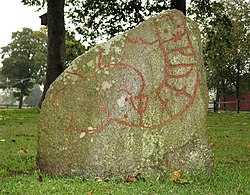
Haakon Ericsson (Old Norse: Hákon Eiríksson; Norwegian: Håkon Eiriksson; died c. 1029–1030) was the last Earl of Lade and governor of Norway from 1012 to 1015 and again from 1028 to 1029 as a vassal under Danish King Knut the Great.
Biography
Håkon Eiriksson was from a dynasty of Norwegian rulers in the eastern part of Trondheim, bordering the Trondheimsfjord. He was the son of Eirik Håkonson, ruler of Norway and earl of Northumbria. His mother is commonly believed to have been Gytha, a daughter of Sweyn Forkbeard and Sigrid the Haughty of Denmark and half-sister of King Knut. After the Battle of Svolder, Eirik Håkonson, with his brother Sveinn Hákonarson, became kings of Norway under Sweyn Forkbeard. In 1014 or 1015 Eirik Håkonson left Norway and joined Knut for his campaign in England. The north English earldom of Northumbria was given by Knut to Eirik after he won control of the north. Eirik remained as earl of Northumbria until his death between 1023 and 1033.
As his father's successor in Norway, Håkon Eiriksson ruled as a Danish vassal from 1012 to 1015, with Einar Tambarskjelve as his aide and his uncle, Sveinn Hákonarson, holding some areas as a Swedish vassal. After some years' absence in England fighting the Danes, Olaf Haraldsson returned to Norway in 1015 and declared himself king, obtaining the support of the petty kings of the Uplands. In 1016, Olaf defeated Sveinn Hákonarson at the Battle of Nesjar. After the victory of Olaf Haraldsson, Håkon fled to England where he was well received by King Knut and made Earl of Worcester. After the Battle of the Helgeå, Norwegian nobles rallied behind Knut.
He is recorded as being the ruler of the Sudreyar from 1016 until 1030. In 1028, Håkon Eiriksson returned as Knut's vassal ruler of Norway.
Håkon died in a shipwreck in the Pentland Firth, between the Orkney Islands and the Scottish mainland, in either late 1029 or early 1030.
Notes
- M. K. Lawson, Cnut: England's Viking King (2004), p. 93
- Olav den Hellige - Norges evige konge Archived 2010-04-08 at the Wayback Machine
- Woolf (2007) p. 246
- "Trøndelag (D4DR Media)". Archived from the original on 16 July 2011. Retrieved 27 February 2010.
References
- Woolf, Alex (2007), From Pictland to Alba, 789–1070, The New Edinburgh History of Scotland, Edinburgh: Edinburgh University Press, ISBN 978-0-7486-1234-5
Further reading
- Forte, A. Viking Empires (Cambridge, New York: Cambridge University Press, 2005)
- Christiansen, Eric The Norsemen in the Viking Age (Blackwell Publishing. 2002)
| Hákon EiríkssonHouse of Hlaðir Died: 1029 or 1030 | ||
| Political offices | ||
|---|---|---|
| Preceded byEiríkr Hákonarson | Jarl of Hlaðir 995–1023 |
Title ended |
| Regnal titles | ||
| Preceded byEiríkr Hákonarson & Sveinn Hákonarson |
Regent of Norway 1012–1015 with Sveinn Hákonarson |
Succeeded byOlaf the Saintas King of Norway |
| Preceded byOlaf the Saintas King of Norway | Regent of Norway 1028–1029 with Canute the Great |
Succeeded bySveinn Álfífuson & Canute the Great |
| Rulers of the Kingdom of the Isles | |
|---|---|
| 9th century | |
| 10th century | |
| 11th century | |
| 12th century | |
| 13th century | |
| ^ Speculative | |